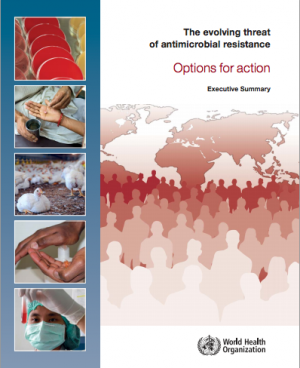Antimicrobial Resistance: Difference between revisions
No edit summary |
No edit summary |
||
| Line 1: | Line 1: | ||
[[Image:Antimicrobial Resistance.png|thumb|right|"The evolving threat of antimicrobial resistance - Options for action". Policy document from WHO]] | |||
== Introduction == | |||
Antimicrobial resistance (AMR) is not a recent phenomenon, but it is a critical health issue today. Over several decades, to varying degrees, bacteria causing common infections have developed resistance to each new antibiotic, and AMR has evolved to become a worldwide health threat. With a dearth of new antibiotics coming to market, the need for action to avert a developing global crisis in health care is increasingly urgent. | |||
== Resources == | In addition to a substantial financial burden that national health-care budgets can ill afford, AMR has economic consequences far beyond the health sector, such as damaging repercussions on international travel and trade resulting from the cross-border spread of resistant infections. The cost of not acting against AMR needs to be considered when deciding resource allocation and assessing interventions. | ||
== Resources == | |||
[http://www.who.int/patientsafety/implementation/amr/publication/en/index.html The evolving threat of antimicrobial resistance - Options for action<ref>The evolving threat of antimicrobial resistance - Options for action. WHO. 2012</ref>] describes examples of policy activities that have addressed antimicrobial resistance in different parts of the world, with the aim of raising awareness and in particular to stimulate further co-ordinated efforts. | [http://www.who.int/patientsafety/implementation/amr/publication/en/index.html The evolving threat of antimicrobial resistance - Options for action<ref>The evolving threat of antimicrobial resistance - Options for action. WHO. 2012</ref>] describes examples of policy activities that have addressed antimicrobial resistance in different parts of the world, with the aim of raising awareness and in particular to stimulate further co-ordinated efforts. | ||
== References == | == References == | ||
<references /> | <references /> | ||
Revision as of 13:49, 4 December 2012
Introduction[edit | edit source]
Antimicrobial resistance (AMR) is not a recent phenomenon, but it is a critical health issue today. Over several decades, to varying degrees, bacteria causing common infections have developed resistance to each new antibiotic, and AMR has evolved to become a worldwide health threat. With a dearth of new antibiotics coming to market, the need for action to avert a developing global crisis in health care is increasingly urgent.
In addition to a substantial financial burden that national health-care budgets can ill afford, AMR has economic consequences far beyond the health sector, such as damaging repercussions on international travel and trade resulting from the cross-border spread of resistant infections. The cost of not acting against AMR needs to be considered when deciding resource allocation and assessing interventions.
Resources[edit | edit source]
The evolving threat of antimicrobial resistance - Options for action[1] describes examples of policy activities that have addressed antimicrobial resistance in different parts of the world, with the aim of raising awareness and in particular to stimulate further co-ordinated efforts.
References[edit | edit source]
- ↑ The evolving threat of antimicrobial resistance - Options for action. WHO. 2012







